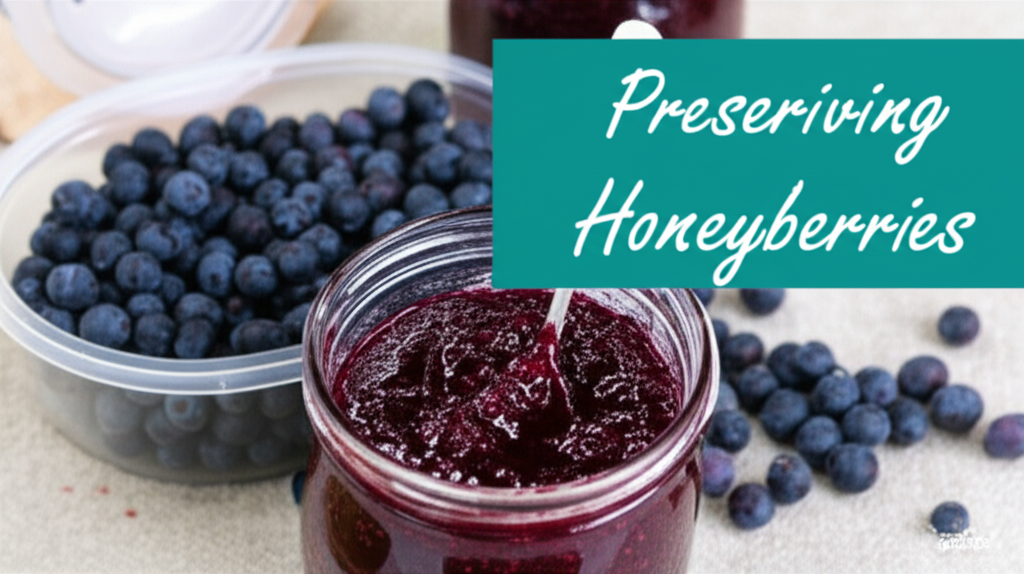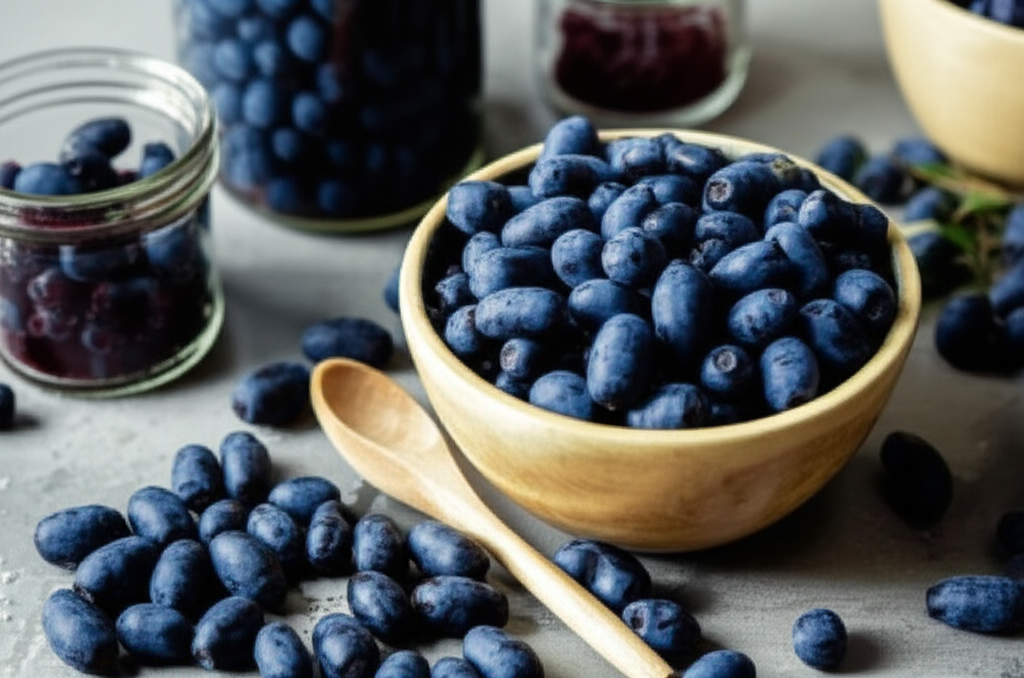Introduction to Honeyberry Preservation
Honeyberries, also known as Haskap berries, are a nutritional powerhouse offering a unique tart-sweet flavor profile that is gaining popularity among home gardeners and food enthusiasts. These resilient shrubs, native to colder climates, produce abundant harvests of jewel-toned berries that are packed with antioxidants, vitamins, and fiber. While their fresh season is relatively short, the true magic of honeyberries lies in their versatility for preservation. This article delves into the best methods for preserving honeyberries, focusing on creating delicious jams and ensuring extended storage, empowering you to enjoy their vibrant taste year-round.
Why Preserve Honeyberries?
The primary reason for preserving honeyberries is to extend their availability beyond their natural fruiting period. Fresh honeyberries are typically available for only a few weeks in late spring or early summer, depending on the variety and your geographical location. Preservation techniques allow you to capture this fleeting harvest and enjoy its benefits throughout the year. Furthermore, preserved honeyberries can be used in a wide array of culinary applications, from breakfast spreads to baked goods and even savory dishes.
Understanding Honeyberry Characteristics for Preservation
Honeyberries have a distinct texture and flavor that can influence preservation methods. They are generally less firm than blueberries, with a slightly softer skin. Their intense tartness, which mellows when cooked, makes them ideal for jams, jellies, and sauces. Understanding these characteristics helps in selecting the most effective preservation techniques to maintain their quality and flavor.
Honeyberry Jam: A Sweet and Tangy Delight

Making honeyberry jam is one of the most popular and rewarding ways to preserve this versatile fruit. The natural pectin content in honeyberries, though variable by variety, often aids in thickening, but you may need to adjust with added pectin or cooking time.
Key Ingredients for Honeyberry Jam
- Honeyberries: Freshly picked and rinsed.
- Sugar: Granulated sugar is standard, but alternatives like honey or maple syrup can be used with adjustments to cooking time and flavor.
- Lemon Juice: Adds acidity, enhancing flavor and aiding in gel formation.
- Pectin: Either naturally occurring or added, depending on your desired consistency and the specific honeyberry variety.
Simple Honeyberry Jam Recipe
This is a basic recipe that can be adapted to your liking.
Ingredients:
- 4 cups honeyberries
- 3 cups granulated sugar (adjust to taste)
- 2 tablespoons lemon juice
- 1 packet (1.75 oz) powdered fruit pectin (optional, if you prefer a firmer set or your berries are low in natural pectin)
Instructions:
- Prepare the honeyberries: Wash and rinse the honeyberries thoroughly. Remove any stems or debris. You can lightly crush them or leave them whole for a chunkier jam.
- Combine ingredients: In a large, heavy-bottomed pot, combine the honeyberries and lemon juice. If using added pectin, stir it in with the sugar before adding to the pot.
- Cook the jam: Bring the mixture to a rolling boil over medium-high heat, stirring constantly.
- Add sugar: If you haven’t added it with pectin, gradually stir in the sugar until dissolved.
- Boil until set: Continue to boil, stirring frequently, until the jam reaches the gelling point. This can be tested by placing a small spoonful of jam onto a chilled plate; it should wrinkle when you push it with your finger. The exact cooking time will vary but typically ranges from 10-25 minutes.
- Skim foam: Skim off any foam that rises to the surface.
- Jar the jam: Ladle the hot jam into sterilized jars, leaving about 1/4 inch headspace. Wipe the rims clean and apply lids.
- Process for storage: Process the jars in a boiling water bath for 10 minutes (adjusting for altitude). For freezer jam, cool completely and store in the refrigerator or freezer.
Tips for Perfect Honeyberry Jam
- Fruit-to-Sugar Ratio: A common ratio is 1:1 for fruit to sugar, but you can reduce the sugar for a tarter jam or a more pronounced berry flavor.
- Testing for Set: Besides the chilled plate test, you can use a candy thermometer, aiming for around 220°F (104°C).
- Variations: Experiment with adding other fruits like blueberries or raspberries, or spices like cinnamon or ginger for unique flavor profiles.
Other Preservation Methods for Honeyberries
While jam is a classic, honeyberries lend themselves well to several other preservation techniques, each offering unique benefits and applications.
Freezing Honeyberries
Freezing is arguably the simplest and most effective method for preserving the nutritional integrity and fresh flavor of honeyberries.
How to Freeze Honeyberries:
- Wash and Dry: Gently wash the honeyberries and ensure they are completely dry. Excess moisture can lead to ice crystals and mushy berries.
- Flash Freezing: Spread the dry berries in a single layer on a baking sheet lined with parchment paper. Place the baking sheet in the freezer for 1-2 hours, or until the berries are frozen solid.
- Package for Storage: Transfer the frozen berries into airtight freezer bags or containers. Remove as much air as possible before sealing.
- Label and Store: Label the bags with the date and contents. Store in the freezer for up to 12 months.
Uses for Frozen Honeyberries:
- Smoothies and shakes
- Baking (pies, muffins, crumbles)
- Sauces and compotes
- Adding to yogurt or oatmeal
Drying Honeyberries
Dehydrating honeyberries concentrates their flavor, creating a chewy, intensely sweet-tart snack.
Dehydrating Honeyberries:
- Prepare Berries: Wash and dry the honeyberries. For more even drying, you can lightly crush them or prick them with a fork.
- Dehydrator Method: Arrange the berries in a single layer on dehydrator trays. Set the dehydrator to 135°F (57°C) and dry for 12-24 hours, or until the berries are leathery and chewy.
- Oven Method: If you don’t have a dehydrator, you can use your oven at its lowest setting (around 140-150°F or 60-65°C). Prop the oven door open slightly to allow moisture to escape. Drying time will be similar to a dehydrator.
- Cool and Store: Once dried, allow the honeyberries to cool completely. Store them in airtight containers in a cool, dry place.
Tips for Dried Honeyberries:
- Ensure berries are thoroughly dry to prevent mold.
- Store in airtight containers away from light and moisture.
- They can be rehydrated in water or juice for use in recipes.
Honeyberry Juice and Syrups
Honeyberry juice and syrups are excellent ways to capture the vibrant color and flavor of the berries.
Making Honeyberry Juice:
- Juicing Method: Combine honeyberries with a small amount of water in a pot and simmer until soft. Strain the mixture through a cheesecloth-lined sieve, pressing gently to extract the juice.
- Sweetening: The juice can be consumed as is or sweetened with sugar or honey to taste.
- Preserving Juice: For longer storage, you can can the juice using a boiling water bath method, or freeze it in ice cube trays or freezer-safe containers.
Making Honeyberry Syrup:
- Boil Berries and Sugar: Combine honeyberries, sugar, and a little water in a pot. Simmer until the berries break down and the liquid thickens into a syrup consistency.
- Strain: Strain the syrup to remove solids.
- Storage: Pour into sterilized bottles. Refrigerate for a few weeks or can for longer shelf life.
Key Facts and Comparison of Preservation Methods
Understanding the nuances of each preservation method is crucial for selecting the best approach for your needs. Here’s a comparison of common methods for honeyberry preservation.
| Method | Pros | Cons | Best For | Typical Shelf Life (Unopened) |
|---|---|---|---|---|
| Jam | Excellent flavor, convenient spread, long shelf life when canned | Requires cooking, higher sugar content, potential for pectin issues | Toast, pastries, cheesecake topping | 1-2 years (canned) |
| Freezing | Simple, preserves nutrients and fresh flavor, versatile for cooking | Requires freezer space, can lead to mushy texture upon thawing | Smoothies, baking, sauces | 12 months |
| Drying | Concentrated flavor, portable snack, reduces volume for storage | Requires specialized equipment or long drying times, can alter texture significantly | Snacks, trail mix, baking | 6-12 months (properly stored) |
| Juice/Syrup | Refreshing beverage, versatile sweetener, vibrant color | Requires juicing equipment or careful straining, can be high in sugar | Drinks, desserts, pancake topping | 1-2 years (canned juice), weeks (refrigerated syrup) |
Steps to Ensure Successful Honeyberry Preservation
Regardless of the method chosen, a few fundamental steps will significantly increase your chances of successful and delicious honeyberry preservation.
| Step | Description | Importance |
|---|---|---|
| 1. Harvest at Peak Ripeness | Pick honeyberries when they are fully colored and slightly soft to the touch. | Ensures optimal flavor and sugar content. Underripe berries will be too tart, overripe berries may be mushy. |
| 2. Gentle Handling | Handle honeyberries with care to avoid bruising or breaking the delicate skins. | Prevents premature spoilage and loss of juices, which can affect texture and flavor. |
| 3. Thorough Cleaning | Wash berries under cool running water and gently pat them dry. | Removes dirt, debris, and any potential contaminants. Ensure dryness for methods like freezing. |
| 4. Sterilize Equipment | Jars, lids, utensils, and any containers used for preservation should be sterilized. | Crucial for preventing spoilage and ensuring food safety, especially for canning. |
| 5. Proper Sealing (for Canning) | Ensure jars are sealed correctly after processing to create a vacuum seal. | Maintains the integrity of the preserved product and prevents the entry of microorganisms. |
| 6. Appropriate Storage Conditions | Store preserved goods in cool, dark, and dry places. | Helps to maintain quality and prevent degradation over time. |
Storage and Shelf Life Considerations
Proper storage is the final, critical step in enjoying your preserved honeyberries.
Long-Term Storage for Canned Goods
Canned honeyberry jam and juice, when properly processed and sealed, can last for 1 to 2 years in a cool, dark pantry. Always check jars for any signs of spoilage, such as bulging lids or cloudy contents, before consuming.
Freezer Storage
Frozen honeyberries, when stored in airtight packaging, will retain good quality for up to 12 months. While they remain safe to eat beyond this period, their texture and flavor may degrade.
Storage of Dried Honeyberries
Dried honeyberries should be stored in airtight containers in a cool, dark, and dry place. They can typically last for 6 to 12 months, though their chewiness may increase over time.
Conclusion: Savoring the Harvest
Preserving honeyberries is a rewarding endeavor that allows you to capture the unique flavor and nutritional benefits of these remarkable berries. Whether you choose to create a sweet and tangy jam, freeze them for later use, dry them for a concentrated snack, or extract their vibrant juice, each method offers a delicious way to extend the enjoyment of your honeyberry harvest. By following these guidelines and understanding the principles of food preservation, you can ensure that the goodness of honeyberries graces your table throughout the year. Happy preserving!


